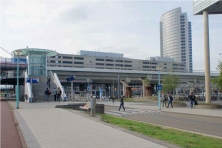Urban Platform. Digital Work and Placemaking for Piarcoplein
Amsterdam Piarcoplein (NL) - Runner up
TEAM DATA
Team Representative: Michele Angelo Valliceli (IT) – architect
Associates: Giulia Panadisi (IT), Annalisa Pilati (IT) – architects
via Cassia 901/a, 00189 Rome (IT)
+39 339 641 6731 – info@nodearchitecture.it – nodearchitecture.it
See the complete listing of portraits here
See the site page here

M. Valliceli, G. Panadisi & A. Pilati
INTERVIEW
Click on the images to enlarge
1. How did you form the team for the competition?
NODE studio is an open platform which combines practice and research in the field of architecture in its relationship with new media technologies. As we're not an "office", we have a flexible organization and we include members who want to contribute to projects aligned with the platform main goals and interests. For this competition the team was formed by the two founding members and a new architect.
2. How do you define the main issue of your project, and how did you answer on this session main topic: the place of productive activities within the city?
We looked at the way in which new digital technologies are transforming workplace, responding to this through physical and digital connectivity. We wanted to propose from the beginning a digital infrastructure capable of making a local and collaborative environment at the district scale - a City OS. From the physical side, our point was to go beyond the idea of co-working or collaborative spaces, making workplaces part of the urban space.
3. How did this issue and the questions raised by the site mutation meet?
Piarcoplein is currently a "disconnected hub": there is a very high accessibility which is not linked to the local pedestrian system. We considered accessibility as a powerful productive resource: our goal has been to design the missing links, in a non-static way, preserving movement, interactions and adaptability over time.
4. Have you treated this issue previously? What were the reference projects that inspired yours?
Urban implications of digital work - as an aspect of productivity - have been widely treated, as its main field of research, in the PhD dissertation of one of our members last June 2017 entitled "La città senza uffici. Uno scenario di rigenerazione urbana per i luoghi del lavoro digitale" part of which has been currently published in this contribution.
This aspect was treated especially for the European context and thanks to Europan we had the chance to experiment these research findings as a real project. NDSM in Amsterdam inspired our concept of workplaces flexibility over time and openness as successful example of urban regeneration; London Harrow Town Centre could very well express the idea of public space productivity and local interaction while Brussels Productive Avenues could integrate this with the accessibility issues, crucial also for Piarcoplein.


5. Urban-architectural projects like the ones in Europan can only be implemented together with the actors through a negotiated process and in time. How did you consider this issue in your project?
Our proposal was conceived as a linear pedestrian system to be developed in four temporal phases: from the first ones connecting Carrascoplein, Orlyplein and Piarcoplein in a mid-level loop to progressively moving parking densities underground and making an empty square with adaptable programs under existing railway tracks. The last phases would have increased pedestrian connectivity through a further development of the mid-level pedestrian system, if needed.
6. Is it the first time you have been awarded a prize at Europan? How could this help you in your professional career?
Yes, it is our first time being awarded at Europan and we hope, thanks to this opportunity, to be able to make our work visible to public administrations and to case developers. We believe that having their feedback would be very precious for us, contributing to our professional growth and would strongly improve our knowledge about this and future works.





